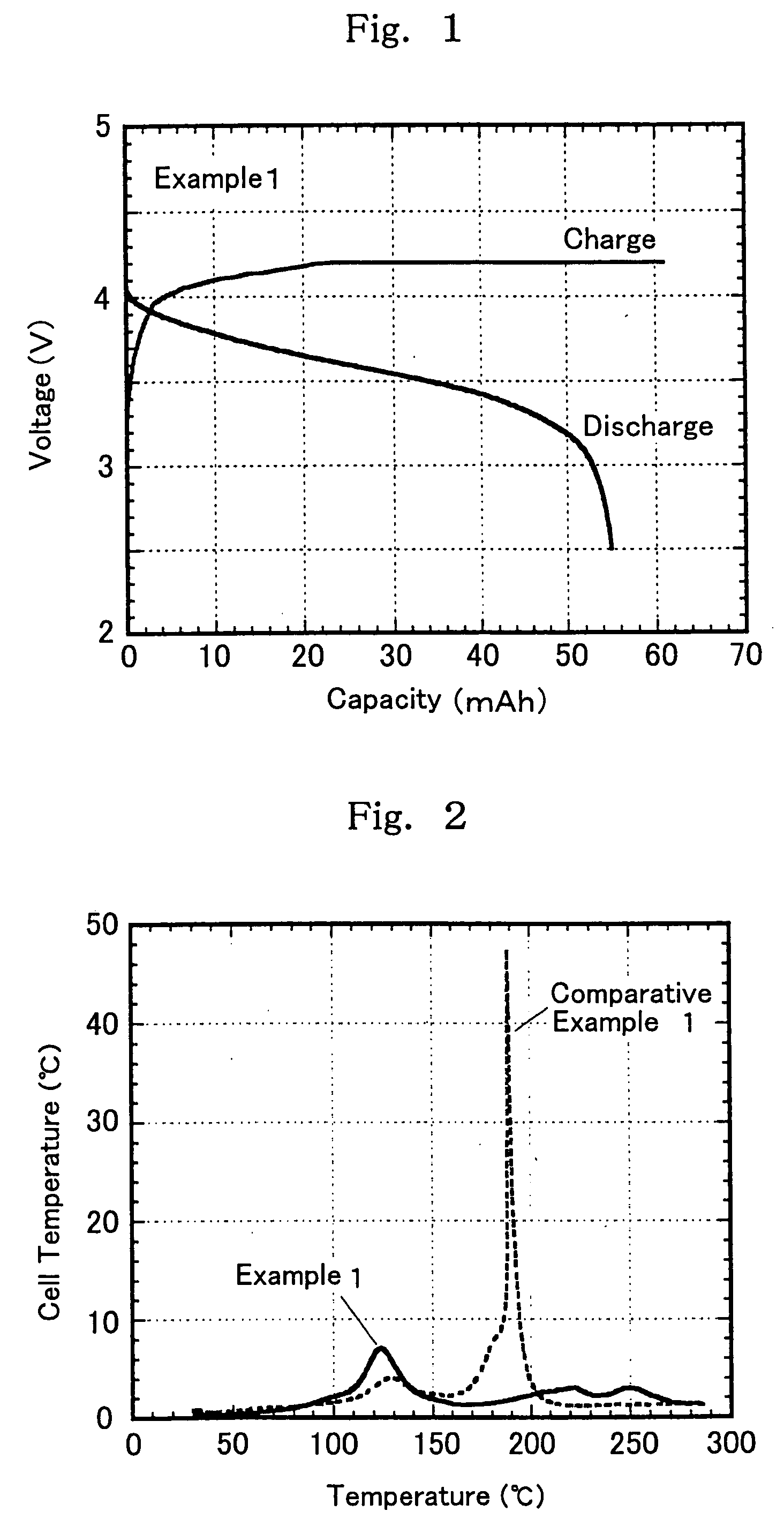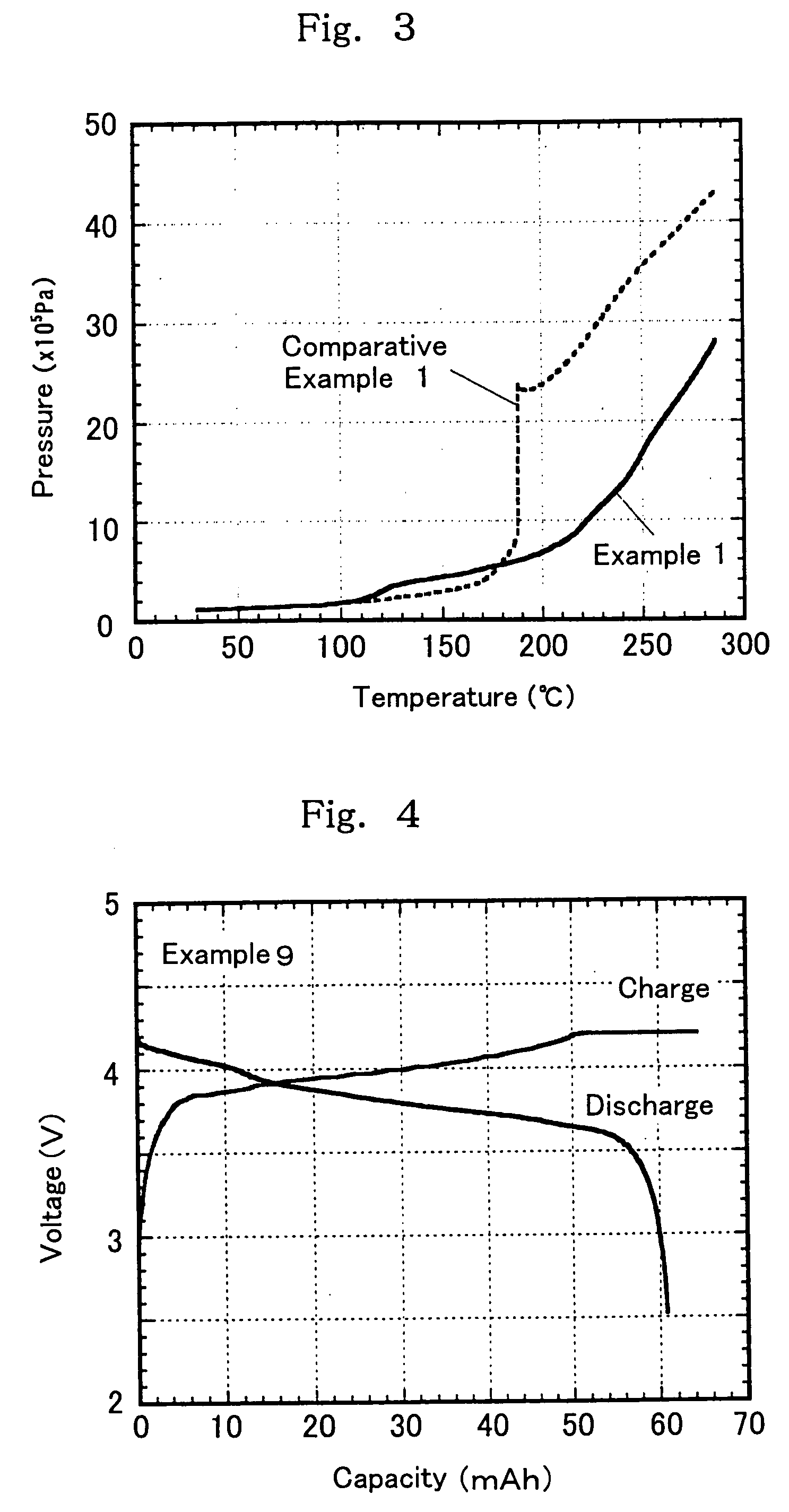Non-aqueous electrolyte and lithium secondary battery using the same
- Summary
- Abstract
- Description
- Claims
- Application Information
AI Technical Summary
Benefits of technology
Problems solved by technology
Method used
Image
Examples
examples
[0094] Hereinbelow, the present invention will be described in more detail with reference to the following Examples of non-aqueous electrolytes prepared according to the present invention and secondary batteries using the same. The following Examples should not be construed as limiting the scope of the present invention.
[0095] Here, properties of the non-aqueous electrolytes were evaluated in accordance with the following methods.
(1) Self-Extinguishing Property of Electrolyte:
[0096] A strip-form glass fiber filter paper having a width of 15 mm, a length of 300 mm, and a thickness of 0.19 mm was immersed in an electrolyte held in a beaker for 10 minutes or longer so that the glass fiber filter paper was well impregnated with the electrolyte. Then, the excess electrolyte soaking the glass fiber filter paper was dripped off at the edge of the beaker for a while, and the glass fiber filter paper was then vertically held with a clip at its end. The glass fiber filter paper was heated...
examples 1 to 8
[0100] In non-aqueous mixed solvents comprising a chain state phosphate (a1), a cyclic phosphate (a2), and a cyclic carboxylate (b1) and having a predetermined volume ratio of the chain state phosphate (a1) and the cyclic carboxylate (b1) and containing a predetermined amount of the cyclic phosphate (a2) shown in Table 1 below, was individually dissolved a lithium salt as a solute to prepare non-aqueous electrolytes 1 in Examples 1 to 8 having a solute concentration of 1 mol / dm3. On the other hand, the non-aqueous electrolytes in Comparative Examples 1 to 3 are non-aqueous electrolytes which do not contain the cyclic carboxylate (b1) and / or the cyclic phosphate (a2). Next, with respect to each of these electrolytes, a self-extinguishing property (flame retardancy) and a conductivity were measured.
[0101] Further, using the electrolytes shown in Table 1 below, synthetic graphite as an anode active material, and LiCoO2 as a cathode active material, cylindrical-form battery elements we...
examples 9 to 19
[0108] In non-aqueous mixed solvents comprising a chain state phosphate (a1) and a cyclic carboxylate (b1) and having a predetermined volume ratio shown in Table 2 below, were individually dissolved a predetermined amount of a vinylene carbonate compound (c1) or a vinylethylene carbonate compound (c2) and a lithium salt as a solute to prepare non-aqueous electrolytes 2 in Examples 9 to 19 having a solute concentration of 1 mol / dm3. On the other hand, the non-aqueous electrolytes in Comparative Examples 4 to 6 are non-aqueous electrolytes which do not contain cyclic carboxylate (b1) and / or vinylene carbonate compound (c1) or vinylethylene carbonate compound (c2). Next, with respect to each of these electrolytes, a self-extinguishing property (flame retardancy) and a conductivity were measured.
[0109] Further, using the electrolytes shown in Table 2 below, synthetic graphite as an anode active material, and LiCoO2 as a cathode active material, cylindrical-form battery elements were pr...
PUM
 Login to View More
Login to View More Abstract
Description
Claims
Application Information
 Login to View More
Login to View More - R&D
- Intellectual Property
- Life Sciences
- Materials
- Tech Scout
- Unparalleled Data Quality
- Higher Quality Content
- 60% Fewer Hallucinations
Browse by: Latest US Patents, China's latest patents, Technical Efficacy Thesaurus, Application Domain, Technology Topic, Popular Technical Reports.
© 2025 PatSnap. All rights reserved.Legal|Privacy policy|Modern Slavery Act Transparency Statement|Sitemap|About US| Contact US: help@patsnap.com



